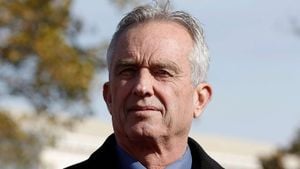With the Democratic National Convention lighting up Chicago, all eyes are on Vice President Kamala Harris as she prepares to accept the party’s presidential nomination. The convention, stretching from August 19 to 22 at the United Center, marks the 26th political convention hosted by the Windy City. On Thursday evening, Harris will convey her vision for the nation to voters across the country, especially after the swift rally of party support following President Joe Biden's reelection withdrawal.
The convention serves as not just a platform for Harris, but also solidifies the standing of the Democratic Party as it heads toward the forthcoming elections. With history echoing through the streets of Chicago—where political giants like Abraham Lincoln have stepped up to the podium—the Democrats are at a pivotal moment.
But this moment isn't devoid of pressing issues affecting the Party’s future. Looking at the wider political battlefield, there’s growing concern within Democratic circles about the demographics and electoral shifts impacting their vote counts. Recent analyses indicate troubling signs — if demographic and geographic trends continue, even capturing historically Democratic strongholds like Wisconsin and Pennsylvania may not suffice.
According to projections from both the liberal Brennan Center and the conservative American Redistricting Project, states like New York and California are on the verge of losing congressional seats due to declining populations, which could rock the Electoral College votes needed to secure future victories for the Democratic Party.
This demographic downturn, especially after recent elections, has some party insiders questioning their long-term strategies. The notion of winning elections merely by sustaining previous voter bases—traditional Democratic voters—seems increasingly tenuous. For the Democratic Party to remain relevant, it’ll have to bridge gaps and connect with new voter segments.
The economic realities faced by citizens largely illuminate these disconnects. A troubling proportion of voters leaving blue states cite housing affordability as the main reason, as highlighted by the Public Policy Institute of California. Over 600,000 residents have fled California alone, searching for more affordable living and opportunities elsewhere. Unsurprisingly, Republican-led states like Texas and Florida have become magnets for migration due to their more attractive economic conditions.
Despite the bright lights of the convention, the looming question of governance rears its head: How can the Democratic Party reconcile its values and actions to retain and attract voters? The cost of living crisis is one signal of poor governance, and Democratic states have often projected themselves as bastions of progressiveness, yet this has not shielded them from the realities of voter frustration.
A sizable ideological rift has emerged around growth policies, where Democratic local governance is beginning to receive scrutiny for its anti-growth stance. This anti-population growth sentiment has permeated political discussions, leading to restrictions on housing development, as noted by urban planner and researcher Greg Morrow, who has outlined Los Angeles's attempts to limit its growth back during the late twentieth century.
Harris’s acceptance speech could play a vast role beyond the convention stage; it might reflect on the party’s capacity to confront its internal challenges and recalibrate its strategies strategically as future elections loom.
It is during such conventions where the party showcases its unity—or fragmentation. With her running mate, Minnesota Governor Tim Walz, already having delivered his acceptance address, the stakes are high, and the emotional undercurrents palpable as the crowd on the convention floor anticipates the spotlight turning to Harris.
The Democratic convention is more than party tradition; it may well serve as the battleground for defining not only their immediate future but also for setting the compass toward more distant electoral endeavors. By crafting a narrative around unity, equity, and forward-thinking policies, the Democrats might stitch together the diverse fabric of voters who have slowly drifted away.
The focus now shifts to Chicago, where familiar chants of "four more years!" will coexist with cautious murmurs: Will Kamala Harris be able to inspire the kind of enthusiasm and hope necessary to engage disillusioned potential voters? The backdrop of soaring housing costs and disparities will weigh on her as she addresses the nation, trying to find the right balance between acknowledging past struggles without veering away from future aspirations.
Indeed, the connection between the party's local governance strategies and their broader electoral success is becoming increasingly evident. For the Democrats to counteract the recent electoral defeats and rising dissatisfaction among constituents, they’ll require innovative strategies aimed at reshaping their communications and policy implementations.
Through the next days, as the Chicago convention buzzes, the narrative the Democratic Party crafts could extensively guide its identity as it tussles with old ghosts and envisions new possibilities. The future of the Democratic Party, it seems, may be entwined with their ability to understand the shifting demographics and economic landscapes across the nation.



